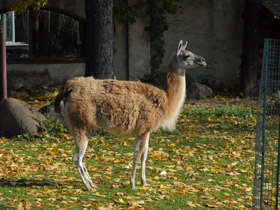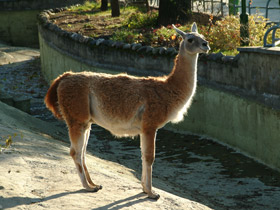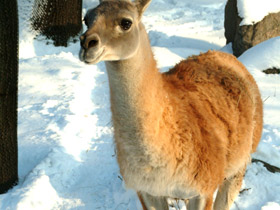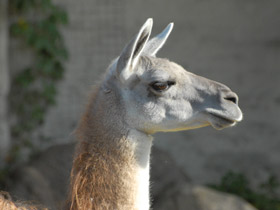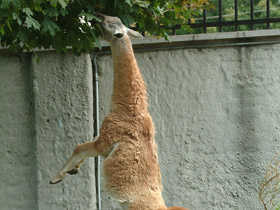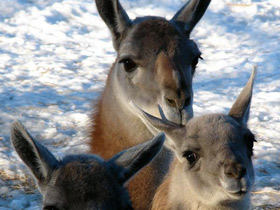Guanaco Lama guanacoe
The guanaco (Lama guanacoe) represents the largest and most common group of wild tylopods of the New World: its body length ranges from 125 to 225 cm, it stands between 90 and 130 centimetres at the shoulders, and weighs 80 to 130 kg. This animal has a delicate, slender structure, similar to that of the deer or antelope but has a longer neck. The head in this humpless camel is also long, and flattened from the sides, the upper lip is covered with thin hairs and is protruding forward; it is split in two and is very flexible. The guanaco has large eyes with thick eyelashes that protect the animal from burning sun, wind, and dust. It has long pointed ears, short tail lucking hairs on its underside, and thick wooly coat. The guanacos are widespread in the steppes, semi-deserts, and mountainous areas from foothills to the margins of snow cover zones (up to 5,000 meter over sea level). These camelids feed on grasses, moss, and lichens; they like to visit salt-marshes and can drink salty or slightly salty water. The guanacos enjoy standing or lying in the mountain streams; they are good swimmers and are capable of running at the speed of 65 km/h. Like other camels, they move by ambling. The guanacos are characterized by some features typical for mountain animals: they have enlarged heart and lungs, and raised red blood cell count.
Guanacos are distributed across high altitude plateaus of the southern Peru and western Bolivia, mountains and foothills of Chile and western Argentina, and plains of Patagonia and Tierra del Fuego. The pre-Columbian population of guanacos had a much wider range, and its size reached 50 million, but today, less than one million of these animals remain in the wild. Wild guanacos live in small harem groups of up to ten animals but may congregate for the nights into large herds consisting of up to 150 specimens. A male controls the individual territory of30 to 65 ha attracting small groups of females to his range. The male guanaco marks the boundaries of his territory with dung heaps (“latrines”), and protects its property from the males from adjusting areas. Sometimes males furiously fight; they display aggressive behaviour by bending their necks and pressing their ears against their heads. If this ritual threat doesn’t scare the enemy away, the male may bite, kick and spit at his competitor. The female guanaco gives birth to a single offspring weighing 8 to 15 kilograms. The mother nurses the calf with her milk rich in fat and nutritional components, and the calf may suck milk as often as ten times a day. Although young guanacos reach sexual maturity by the age of two years, they are chased away from their parents’ territory when they are 7 (males) and 12 (females) months old.

















